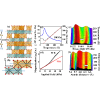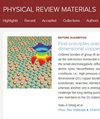Structural mechanism of the magnetic phase transitions in FeTiO3
IF 3.4
3区 材料科学
Q2 MATERIALS SCIENCE, MULTIDISCIPLINARY
引用次数: 0
Abstract
The structural mechanism of the magnetic phase transitions in ilmenite, including the paramagnetic (PM) to antiferromagnetic (AFM) transition induced by reducing temperature in zero magnetic field and the AFM to ferromagnetic (FM) transition induced by applying strong magnetic field at a fixed temperature below the Néel temperature, , are studied by total synchrotron x-ray scattering. It is found that in both cases the concerted effect of Coulomb repulsion, spin-orbit coupling, and exchange interactions is what determines the response of the crystal lattice to variations in external perturbations such as temperature and magnetic field. In particular, due to strong spin-orbit coupling and Coulomb repulsion, Fe and Ti atoms move in sync along the axis of the crystal lattice such that their separation changes by less than 1%. At the same time, due to strong intralayer ferromagnetic interactions, the Fe-O-Fe bond angle becomes closer to . Notably, the direction of the motion occuring during the temperature-induced PM to AFM transition is opposite to that occuring during the magnetic field-induced AFM to FM transition. Altogether, the seemingly simple ilmenite behaves like a complex physical system where charge, spin, orbital, and lattice degrees of freedom are strongly coupled. Our findings are likely to be relevant to other members of the ilmenite family and spin-orbit coupled magnetic insulators in general.

FeTiO3 中磁性相变的结构机制
通过全同步加速器 X 射线散射研究了 FeTiO3 钛铁矿中磁性相变的结构机制,包括在零磁场中降低温度诱导的顺磁(PM)到反铁磁(AFM)转变,以及在低于奈尔温度 TN 的固定温度下施加强磁场诱导的反铁磁到铁磁(FM)转变。研究发现,在这两种情况下,库仑斥力、自旋轨道耦合和交换相互作用的协同效应决定了晶格对温度和磁场等外部扰动变化的响应。特别是,由于自旋轨道耦合和库仑斥力很强,铁原子和钛原子沿晶格的 c 轴同步移动,因此它们之间的距离变化不到 1%。同时,由于强烈的层内铁磁相互作用,Fe-O-Fe 键角变得更接近 90∘。值得注意的是,温度诱导的 PM 向 AFM 转变过程中发生的运动方向与磁场诱导的 AFM 向 FM 转变过程中发生的运动方向相反。总之,看似简单的 FeTiO3 钛铁矿表现得就像一个复杂的物理系统,其中电荷、自旋、轨道和晶格自由度紧密耦合。我们的发现可能与钛铁矿家族的其他成员以及一般自旋轨道耦合磁绝缘体有关。
本文章由计算机程序翻译,如有差异,请以英文原文为准。
求助全文
约1分钟内获得全文
求助全文
来源期刊

Physical Review Materials
Physics and Astronomy-Physics and Astronomy (miscellaneous)
CiteScore
5.80
自引率
5.90%
发文量
611
期刊介绍:
Physical Review Materials is a new broad-scope international journal for the multidisciplinary community engaged in research on materials. It is intended to fill a gap in the family of existing Physical Review journals that publish materials research. This field has grown rapidly in recent years and is increasingly being carried out in a way that transcends conventional subject boundaries. The journal was created to provide a common publication and reference source to the expanding community of physicists, materials scientists, chemists, engineers, and researchers in related disciplines that carry out high-quality original research in materials. It will share the same commitment to the high quality expected of all APS publications.
 求助内容:
求助内容: 应助结果提醒方式:
应助结果提醒方式:


